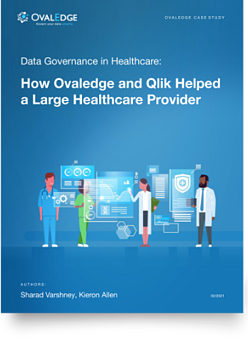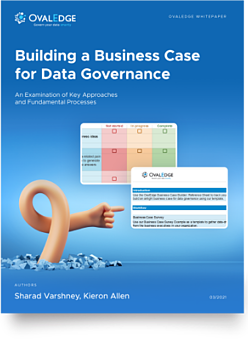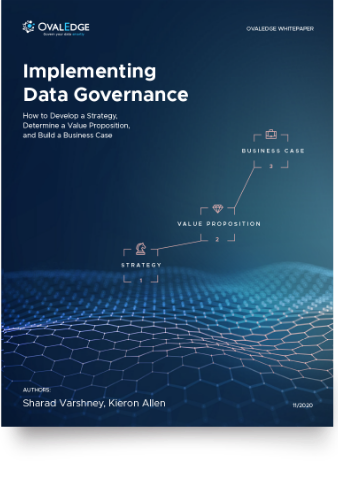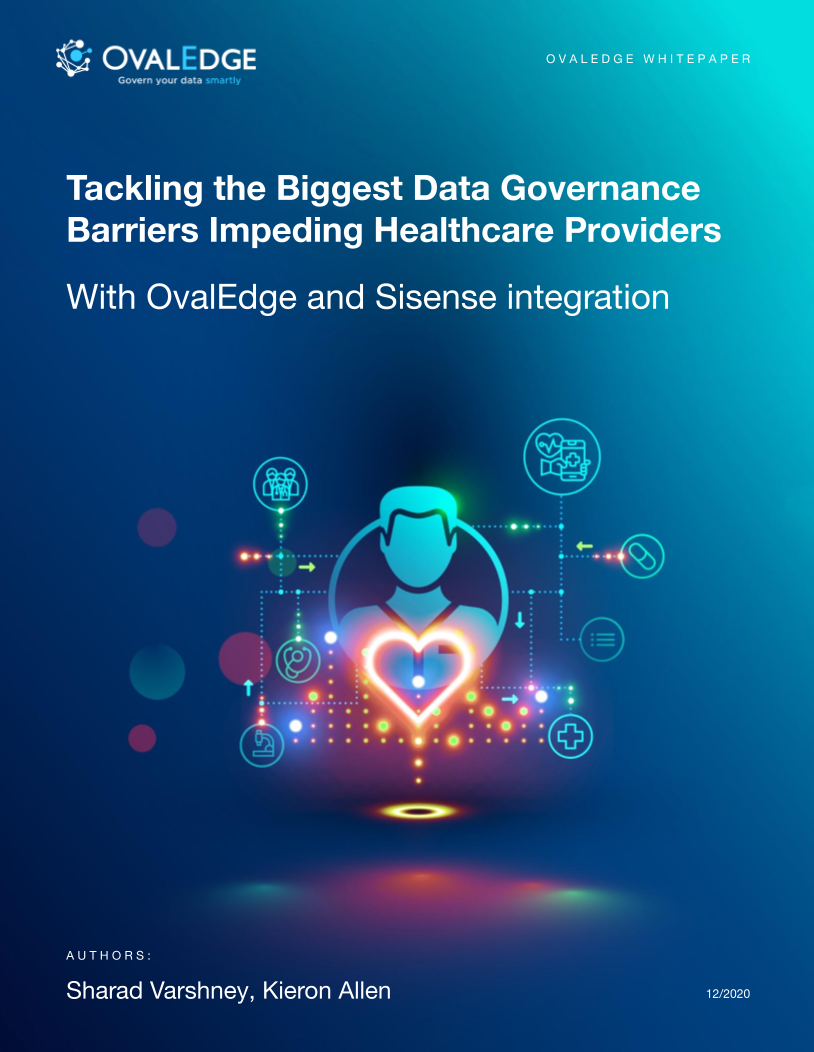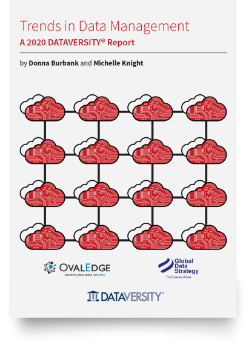Table of Contents
Finding the Right Data Governance Tool in 2025
During a recent conversation, a CDO told me he had just hired a Data Governance Lead who wanted to begin drafting data access policies. "You mentioned that policies only remain on paper if they can't be implemented," he said. "How should we choose the tools and technologies to operationalize our strategy?"
One of the most important decisions you can make when committing to a comprehensive data governance strategy is finding the right tool to support your efforts. As you know, a dedicated tool will help you to streamline and, in many cases, automate various steps of data governance in your organization. In an increasingly complex data environment—even data localization is regulated by 75 percent of countries—it's more important than ever to have the right technological support.
In this blog, I'll explain what a data governance tool is, why you should onboard one, who will use it, and how to choose the best one to suit your organization's needs. Read on to learn how to evaluate the leading data governance tools available today.
Download our free guide to compare the top 6 data governance platforms in 2025
What is a Data Governance Tool?
A data governance tool is a critical function of data governance that enables organizations to better manage and coordinate their data governance efforts. Like a centralized console for enterprise-wide data governance, business and data teams can use a dedicated tool to develop and administer the crucial policies that will enable them to achieve their company’s data governance objectives.
As well as enabling organizations to achieve effective data governance more quickly, a dedicated tool supports other outcomes. Using a tool enables users to enforce security protocols, manage access, monitor data quality improvement, and perhaps most importantly, ensure your company operates within and not outside of regulatory boundaries.
Why Do You Need a Data Governance Tool?
Simply put, data governance is about drafting and implementing policies and procedures. It’s not always complicated to draft these policies and procedures, but unless they can be implemented, they can never lead to tangible results. A data governance tool can help a great deal with transitioning draft policies and procedures into implementable actions.
How companies draft policies and procedures in their organization depends on several factors: most importantly, the current technology landscape and the bandwidth available in the organization.
For example, if a company lacks the resources required to classify data, it's favourable to draft a governance policy that doesn't require extensive data classification. However, classification would be a major policy element centered on universal data access. Another important consideration is the budget. If your budget is limited, as many are, you must commit to a strategy that suits your intended spend.
Drafting policies and procedures must be driven by a comprehensive strategy which includes, at the very least, building a data governance charter, establishing a data governance council, identifying data governance drivers, and understanding organizational maturity.
It’s best practice to understand what the technology can do in various areas, find the best tool for the desired outcomes, devise a strategy based on your bandwidth, and then draft your policy. If you draft a policy without any knowledge of the capabilities of the tools available, it's not going to work. In practice, the implementation may require multiple tools and ultimately exceed your budget.
Conversely, if you just decide to choose a tool without doing your research and then begin drafting policies, there is a risk of failure because your chosen tool may not address your intentions.
Related Short Video: How to choose the best data governance tool for your needs?
The main objective of data governance is compliance. This means developing policies ensuring the right people can access the right, high-quality data. As well as wider compliance regulations, this covers internal policies too. For example, you wouldn't want business users outside of the HR department to have ungoverned access to salary information. Core data governance policies include the following:
Data access policies and procedures
Universal data access isn't possible because there will always be confidential data and personally identifiable information (PII) that must be protected. To that end, in most cases, you can't use any PII data in analytics unless it has been anonymized.
The best practice is to collect all the metadata, classify it, and give access based on these classifications. However, this process doesn't consider how the data is classified.
One way is to classify the data in each application and manage classifications from each individual source. However, this is very hard to implement because every application owner needs to be trained in data classification techniques. Another way is to use a data catalog.
Using this method, all of the metadata is classified in the tool, assigned, and then pushed back using automation. This is a far easier way of implementing data access policies, and costs can be lowered when companies purchase the tool, keeping the metadata in situ. However, there are other options too.
For example, you could draft a policy that didn't enable data access until a senior manager approved it. Another option is to restrict access to the entire applications where PII and confidential data are contained. Yet, both of these options restrict innovation by hindering easy access to data.
While classification is the best policy for data access, it is incredibly hard to do it manually. When you have a clear and well-implemented data access policy supported by an automated data catalog, you open up opportunities for data sharing internally and externally, boosting opportunities for growth.
Data literacy policies and procedures
Advanced data literacy is about managing the metadata quality in your system. Anyone can write a policy that requires every user to publish their metadata. However, this is an impractical ask.
For example, asking an application owner, let's use SAP as an example, to publish all of the data associated with the application, write better technical and business descriptions, and report on the quality of the metadata is unreasonable and incredibly time-consuming. Why would an application owner, who isn't the consumer, but the data producer, use their own resources to carry out this work?
Instead, you have to design policies around curating the metadata. The best practice is to have the application owner curate the metadata and then leave the standardization of the data, the heavy work, to a standardization committee. However, incentives must be in place and a budget allocated to support these efforts.
You must ask important questions like who should become a data steward and why? Otherwise, the policy will be very difficult to implement. The tool you choose should support this functionality. Can you assign a variety of business users as data stewards? Can you calculate the time they spend on these tasks to develop incentives? Is this policy easily implemented using the tool? Is there a curation template available?
Related post: Data Literacy: What it is and How it Benefits Your Business
While a data catalog is the most comprehensive tool for this curation process, other methods exist. Some applications enable users to create a data dictionary. However, if you can't share this asset because it remains in the tool, it is impossible for everyone to leverage this information.
Data quality policies and procedures
High-quality data clearly and accurately represents what the data is. For example, if you want to know your total amount of active customers, that's what the data should show, not the total amount of vendors or historical customers. For data quality policies, you must consider multiple angles.
Users should be vigilant about who can share what data and at what level. Often this is overseen by a Data Operations Group because you can't ensure high-quality data if there are no sharing procedures in place to govern collaboration.
You may want to devise multiple strategies. Perhaps there could be a different strategy to address actions when a problem is found. Who's going to address it? Is the Data Operations Group responsible, or should this fall to application owners? The best practice is to deploy a Data Operations Group to ensure the smooth running of the data pipeline. Various tools can be used to measure data quality and inform the work of the Data Operations Group.
When it comes to drafting data quality policies, there are multiple approaches. Application owners can be responsible for their own data quality, but there must be standards in place for them to follow.
Otherwise, you can outsource these responsibilities to the Data Operations Group. Again, it comes down to budget and bandwidth.
People and Processes
I like to introduce the benefits of data governance tools for processes first because the outcome of these processes ultimately benefits the people in your organization. Data governance tools enable organizations to make and implement policies automatically. As I mentioned, these policies cover every area of data governance, including data quality improvement, access management, data privacy compliance, security, and more.
Within a data governance tool, a business glossary provides users with a comprehensive list of definitions for business terms. This standardization enables organizations to confidently accelerate a data-driven strategy because there is no concern regarding the consistency of terms.
Finally, a data catalog and self-service data access, supported by secure access management and data quality policies, provide a space where any user, regardless of their experience in data analysis, can find, retrieve, and collaborate on data assets. And regular business users aren't the only beneficiaries.
Bringing in automated policies to an increasingly complex data landscape dramatically reduces the workload on data teams. They save time and money and ensure their organization remains compliant. A data governance tool streamlines the structure of data governance in an organization, making it clear who owns the data, how it should be used, its lineage, and who can access it.
Point Solution vs. Enterprise Platform
One of the key considerations you need to make is whether to opt for a point solution or an enterprise platform. Of course, there are pros and cons to both.
Enterprise-grade data governance platforms can address multiple data governance challenges across your organization, including data cataloging and management concerns too. At the enterprise level, you can expect a highly scalable solution that grows in line with your organization.
Usually, enterprise platforms support a large degree of customization and configuration, company-wide collaborative features, and are simple to onboard because they support multiple tasks from a single place. What's more, as a tool designed to be flexible to implement, they adapt to changes as and when you need them.
That said, enterprise platforms can be more expensive than point solutions and require more investment. And, because of the nature of the solution, require buy-in from multiple departments and executives.
Instead of covering multiple use cases, a point solution focuses on a specific data governance challenge, like access management. These solutions are dedicated to solving a specific problem, and they often do it well. They are quick and easy to deploy and less expensive than enterprise platforms. However, there are a large number of downsides.
Opting for single-use solutions is restricting because whenever a new problem arises, you must find a different solution to tackle it. This also inhibits the ability to scale. Over time, introducing multiple-point solutions becomes complex, and the savings made can sometimes be negated by management costs.
It's difficult to ensure company-wide communication and support collaborative efforts because of interoperability issues and the fact that different departments are using different tools. And there's no guarantee that the tools will integrate with your existing business applications.
Related Short Video: Key Suggestions When Implementing Data Governance - Sharad Varshney, CEO
Open-Source vs. Proprietary Software
Another consideration for companies is choosing an open-source or proprietary software option. Again, there are pros and cons to each solution.
The key difference is that open source software is usually free to use and universally available, while proprietary software is paid for in almost every instance and only accessible under license.
As well as being free to use, open source software has open code so companies can manipulate a data governance tool at the development level to suit their needs. This open-source method also means that any user can add, modify, and in theory, improve the solution over time.
However, using open-source data governance software is a gamble. There is no guarantee that it works as it should and that all relevant security checks have been taken to ensure its safety. Perhaps most importantly, there is no dedicated support for the software, something that can be particularly important if a company is just starting out on its data governance journey.
On the other hand, proprietary software requires a paid-for license and can't be edited. However, with this financial commitment comes a series of benefits. Proprietary data governance software is often bug-free, and any patches required to enforce this cybersecurity posture are included as standard.
This applies to updates too. And you can expect a high degree of support as you continue to roll out the tool in your organization.
Who Uses a Data Governance Tool?
A comprehensive data governance tool enables governance policies across an organization. As such, many users within the organization will use and benefit from it.
Data teams can use a data governance tool to automate processes and define policies that streamline data governance. IT departments introduce the tool into a company’s infrastructure, providing a way to reduce the time spent forwarding and managing requests. And business users benefit from a data governance tool through access management and data quality improvement metrics via self-service.
Wrapping it up
The best way to decide which data governance tool will best suit your needs is to compare the leading data governance tools available. In our Data Governance Product Evaluation Guide, we run you through the core features available in the leading tool options and deliver a rating system to make it easy for you to evaluate your options.
What you should do now
|

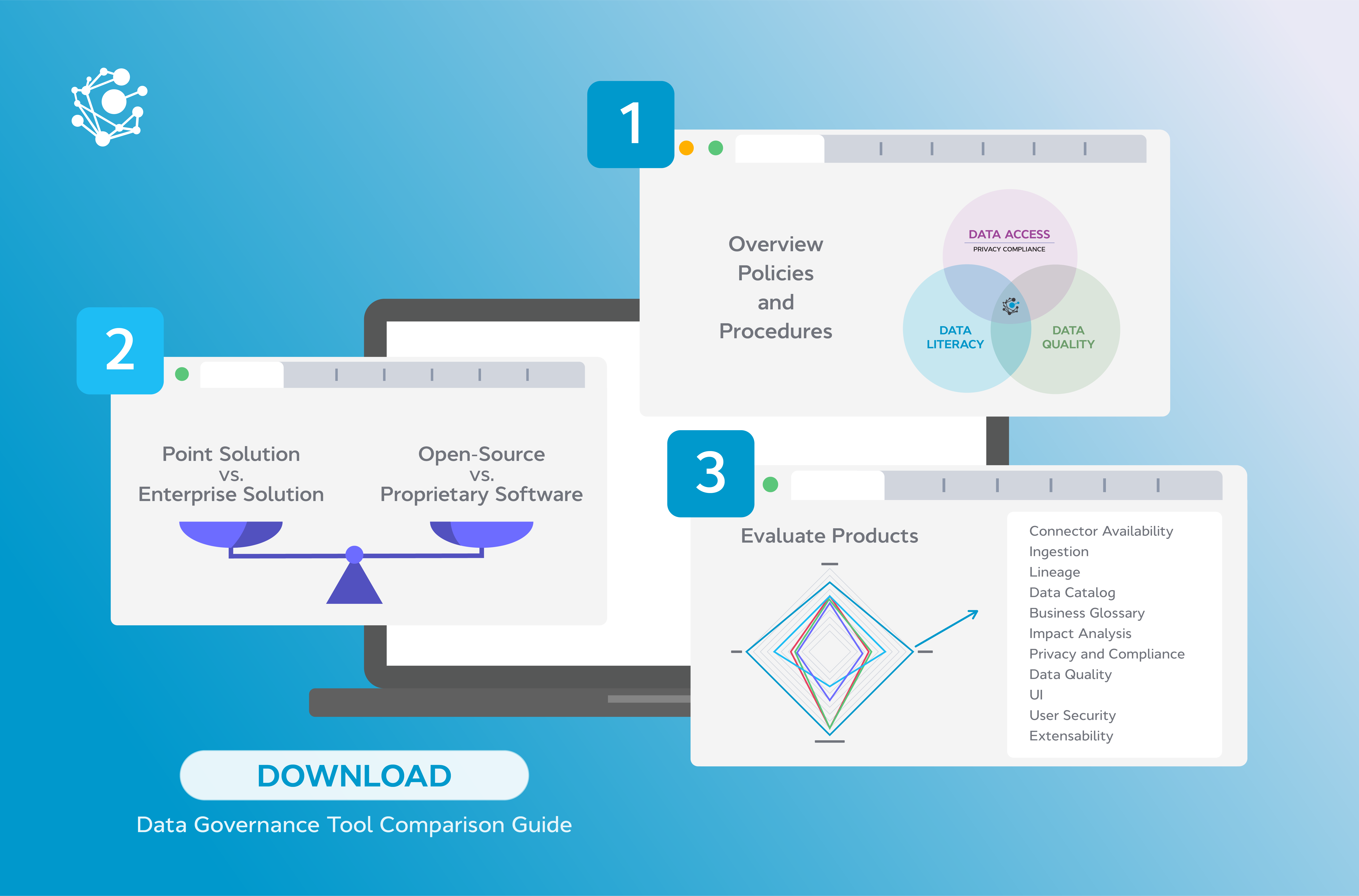
.png?width=694&height=387&name=Infographic_Evaluating%20Data%20Governance%20Platforms_V2%20(1).png)
